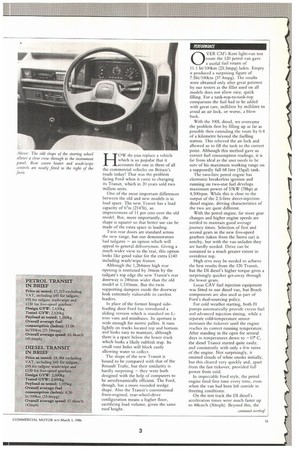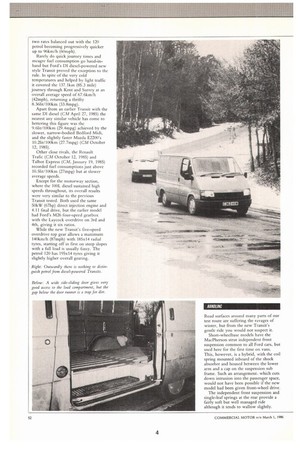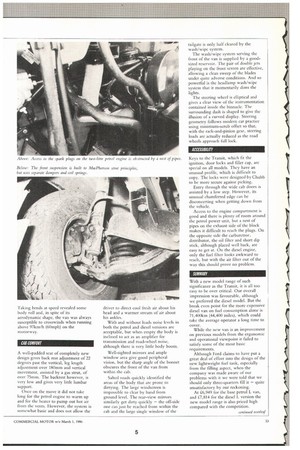H OW do you replace a vehicle which is so popular
Page 145

Page 146

Page 147

If you've noticed an error in this article please click here to report it so we can fix it.
that it accounts for one in three of all the commercial vehicles on Britain's roads today? That was the problem facing Ford when it came to changing its Transit, which in 20 years sold two million units.
One of the most important differences between the old and new models is in load space. The new Transit has a load capacity of 63m (2143ft), an improvement of 11 per cent over the old model. But, more importantly, the shape is squarer so that better usc can be made of the extra space in loading.
Twin rear doors are standard across the new range, but our demonstrators had tailgates — an option which will appeal to general deliverymen. Giving a much wider view to the rear, this option looks like good value for the extra £140 including wash/wipe feature.
Although the 1,264mm high rear opening is restricted by 34mm by the tailgate's top edge the new Transit's rear doorway is 240mm wider than the old model at 1,510mm. But the twin supporting dampers inside the doorway look extremely vulnerable to careless loaders.
In place of the former hinged sideloading door Ford has introduced a sliding version which is standard on trim vans vans and minibuses. Its aperture is wide enough for metric pallets. It runs lightly on tracks located top and bottom and looks easy to maintain, although there is a space below the lower track which looks a likely rubbish trap. Its small vent holes will block easily allowing water to collect.
The shape of the new Transit is bound to be compared with that of the Renault Trafic, but their similarity is hardly surprising — they were both designed with the help of computers to be aerodynamically efficient. The Ford, though, has a more rounded wedge shape. Also the Transit's conventional front-engined, rear-wheel-drive configuration means a higher floor, sacrificing load volume, given the same roof height.
0 VER CM'S Kent light-van test route the 120 petrol van gave a useful fuel return of
11.1 lit/100km (25.5mpg) laden. Empty it produced a surprising figure of 7.51it/100km (37.4mpg). The results were obtained only after great patience by our testers as the filler used on all models does not allow easy, quick filling. For a tank-top-to-tank-top comparison the fuel had to be added with great care, millilitre by millilitre to avoid an air lock, or worse, a blow hack.
With the 100L diesel, we overcame the problem first by filling up as far as possible then extending the route by 0.4 of a kilometre beyond the fuelling station. This relieved the air lock and allowed us to fill the tank to the correct point. Although this method gave us correct fuel consumption readings, it is far from ideal as the user needs to be sure of his maximum working range on a supposedly full 68 litre (15gal) tank.
The two-litre petrol engine has electronic breakerless ignition and running on two-star fuel develops maximum power of 57kW (78hp) at 4,500rpm. While this is close to the output of the 2.5-litre direct-injection diesel engine, driving characteristics of the two are quite different.
With the petrol engine, far more gear changes and higher engine speeds are needed to maintain good average journey times. Selection of first and second gears in the new five-speed gearbox (taken from the Sierra car) is notchy, but with the van unladen they are hardly needed. Drive can be sustained to a much greater extent in overdrive top.
High revs may be needed to achieve the best results from the 120 Transit, but the DI diesel's higher torque gives a surprisingly quicker get-away through the lower gears.
Lucas CAV fuel injection equipment was fitted to our diesel van, but Bosch components are also used as part of Ford's dual-sourcing policy.
For cold weather starting, both Fl pumps automatically provide excess fuel and advanced injection timing, while a separate cold-temperature sensor increases the tickovcr until the engine reaches its correct running temperature. After standing in the open for several days in temperatures down to —10° C, the diesel Transit started quite easily, and consistently with only a few turns of the engine. Not surprisingly, it emitted clouds of white smoke initially, but this cleared very quickly and, apart from the fast tickover, provided full power from cold.
In impeccable Ford style, the petrol engine fired first time every time, even when the van had been left outside in freezing conditions.
On the test track the DI diesel's acceleration times were much faster up to 48km/h (30mph). Beyond this, the
two rates balanced out with the 120 petrol becoming progressively quicker up to 96km/h (60mph).
Rarely do quick journey times and meagre fuel consumption go hand-inhand but Ford's 1)1 diesel-powered new style Transit proved the exception to the rule. In spite of the very cold temperatures and helped by light traffic it covered the 137.1km (85.3 mile) journey through Kent and Surrey at an overall average speed of 67.6km/h (42mph), returning a thrifty 8.361it/100km (33.8mpg).
Apart from an earlier Transit with the same DI diesel (CM April 27, 1985) the nearest any similar vehicle has come to bettering this figure was the 9.61it/I0Okm (29.4mpg) achieved by the slower, narrow-bodied Bedford Midi, and the slightly faster Mazda E2200's 10.21it/100km (27.7mpg) (CM October 12, 1985).
Other close rivals, the Renault Trafic (CM October 12, 1985) and Talbot Express (CM, January 19, 1985) recorded fuel consumptions just above 10.51it/100km (27mpg) but at slower average speeds.
Except for the motorway section, where the 100L diesel sustained high speeds throughout, its overall results were very similar to the previous Transit tested. Both used the same 50k W (67hp) direct injection engine and 4.11 final drive, but the earlier model had Ford's M26 four-speed gearbox with the Laycock overdrive on 3rd and 4th, giving it six ratios.
While the new Transit's five-speed overdrive top gear allows a maximum 140km/h (87mph) with 185x14 radial tyres, starting off in first on steep slopes with a full load is usually fussy. The petrol 120 has 195x14 tyres giving it slightly higher overall gearing. Road surfaces around many parts of our test route are suffering the ravages of winter, but from the new Transit's gentle ride you would not suspect it. Short-wheelbase models have the MacPherson strut independent front suspension common to all Ford cars, but used here for the first time on vans. This, however, is a hybrid, with the coil spring mounted inboard of the shock absorber and housed between the lower arm and a cap on the suspension sub frame. Such an arrangement, which cuts down intrusion into the passenger space, would not have been possible if the new model had been given front-wheel drive. The independent front suspension and single-leaf springs at the rear provide a fairly soft but well managed ride although it tends to wallow slightly. Taking bends at speed revealed some body roll and, in spite of its aerodynamic shape, the van was always susceptible to crosswinds when running above 97km/h (60mph) on the motorway.
A well-padded seat of completely new design gives back rest adjustment of 22 degrees past the vertical, leg length adjustment over 180mm and vertical movement, assisted by a gas strut, of over 75min. The backrest however, is very low and gives very little lumbar support.
Once on the move it did not take long for the petrol engine to warm up and for the heater to pump out hot air from the vents. However, the system is somewhat basic and does not allow the driver to direct cool fresh air about his head and a warmer stream of air about his ankles.
With and without loads noise levels in both the petrol and diesel versions are acceptable, but when empty the body is inclined to act as an amplifier for transmission and road-wheel noise, although there is very little body boom.
Well-sighted mirrors and ample window area give good peripheral vision, but the sharp angle of the bonnet obscures the front of the van from within the cab.
Salted roads quickly identified the areas of the body that are prone to dirtying. The large windscreen is impossible to clear by hand from ground level. The rear-view mirrors similarly get dirty quickly — the off-side one can just be reached from within the cab and the large single window of the tailgate is only half cleared by the wash/wipe system.
The wash/wipe system serving the front of the van is supplied by a goodsized reservoir. The pair of double jets playing on the front screen are effective. allowing a clean sweep of the blades under quite adverse conditions. And so powerful is the headlamp wash/wipe system that it momentarily dims the lights.
The steering wheel is elliptical and gives a clear view of the instrumentation contained inside the binnacle. The surrounding dash is shaped to give the illusion of a curved display. Steering geometry follows modern car practice using minimum-scrub offset so that, with the rack-and-pinion gear, steering loads are actually reduced as the road wheels approach full lock.
Keys to the Transit, which fit the ignition, door locks and filler cap, are special on all models. They have an unusual profile, which is difficult to copy. The locks were designed by Chubb to be more secure against picking.
Entry through the wide cab doors is assisted by a low step. However, its unusual chamferred edge can be disconcerting when getting down from the vehicle.
Access to the engine compartment is good and there is plenty of room around the petrol power unit, but a nest of pipes on the exhaust side of the block makes it difficult to reach the plugs. On the opposite side the carburettor. distributor, the oil filter and short dip stick, although placed well back, are easy to get at. On the diesel engine, only the fuel filter looks awkward to reach, but with the air filter out of the way this should prove no problem.
With a new model range of such significance as the Transit, it is all too easy to be over critical. Our overall impression was favourable, although we preferred the diesel model. But the break even point for the more expensive diesel van on fuel consumption alone is 71,400km (44,400 miles), which could take the average operator a long time to cover.
While the new van is an improvement on previous models from the ergonomic and operational viewpoint it failed to satisfy some of the most basic requirements.
Although Ford claims to have put a great deal of effort into the design of the new lightweight fuel tank, especially from the filling aspect, when the company was made aware of our problems with it we were told that we should only three-quarters fill it — quite unsatisfactory by our reckoning.
At £6,949 for the base petrol L van, and 0,814 for the diesel L version the new model range is also priced high compared with the competition.














































































































































































